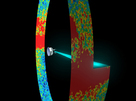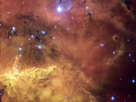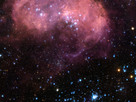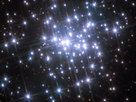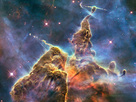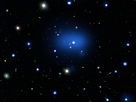The nature of dark energy
First Use of Cosmic Lens to Probe Dark Energy
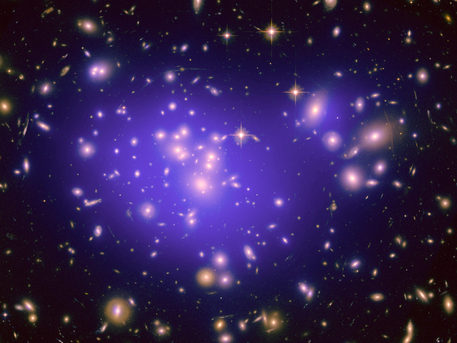 © NASA, ESA, E. Jullo (Jet Propulsion Laboratory), P. Natarajan (Yale University), and J.-P. Kneib (Laboratoire d'Astrophysique de Marseille, CNRS, France)
|
This is the Hubble Space Telescope image of the inner region of Abell 1689, an immense cluster of galaxies located 2.2 billion light-years away. Dark matter in the cluster is mapped by plotting the plethora of arcs produced by the light from background galaxies that is warped by the foreground cluster's gravitational field. Dark matter cannot be photographed, but its distribution is shown in the blue overlay. The dark matter concentration and distribution is then used to better understand the nature of dark energy, a pressure that is accelerating the expansion of the universe. The imaging data used in the natural-color photo was taken in 2002 with Hubble's Advanced Camera for Surveys.
"We have to tackle the dark energy problem from all sides," said Eric Jullo, an astronomer at NASA's Jet Propulsion Laboratory, Pasadena, Calif. "It's important to have several methods, and now we've got a new, very powerful one." Jullo is lead author of a paper on the findings appearing in the Aug. 20 issue of the journal Science.
Scientists aren't clear about what dark energy is, but they do know that it makes up a large chunk of our universe, about 72 percent. Another chunk, about 24 percent, is thought to be dark matter, also mysterious in nature but easier to study than dark energy because of its gravitational influence on matter that we can see. The rest of the universe, a mere 4 percent, is the stuff that makes up people, planets, stars, and everything made up of atoms.
In their new study, the science team used images from Hubble to examine a massive cluster of galaxies, named Abell 1689, which acts as a magnifying, or gravitational, lens. The gravity of the cluster causes galaxies behind it to be imaged multiple times into distorted shapes, sort of like a fun-house mirror reflection that warps your face.
Using these distorted images, the scientists were able to figure out how light from the more distant, background galaxies had been bent by the cluster — a characteristic that depends on the nature of dark energy. Their method also depends on precise ground-based measurements of the distance and speed at which the background galaxies are traveling away from us. The team used these data to quantify the strength of the dark energy that is causing our universe to accelerate.
"What I like about our new method is that it's very visual," said Jullo, "You can literally see gravitation and dark energy bend the images of the background galaxies into arcs."
According to the scientists, their method required multiple, meticulous steps. They spent the last several years developing specialized mathematical models and precise maps of the matter — both dark and "normal" — constituting the Abell 1689 cluster.
"We can now apply our technique to other gravitational lenses," said co-author Priya Natarajan, a cosmologist at Yale University, New Haven, Conn. "We're exploiting a beautiful phenomenon in nature to learn more about the role that dark energy plays in our universe."
Source: Hubblesite
The nature of dark energy
First Use of Cosmic Lens to Probe Dark Energy
 © NASA, ESA, E. Jullo (Jet Propulsion Laboratory), P. Natarajan (Yale University), and J.-P. Kneib (Laboratoire d'Astrophysique de Marseille, CNRS, France)
|
This is the Hubble Space Telescope image of the inner region of Abell 1689, an immense cluster of galaxies located 2.2 billion light-years away. Dark matter in the cluster is mapped by plotting the plethora of arcs produced by the light from background galaxies that is warped by the foreground cluster's gravitational field. Dark matter cannot be photographed, but its distribution is shown in the blue overlay. The dark matter concentration and distribution is then used to better understand the nature of dark energy, a pressure that is accelerating the expansion of the universe. The imaging data used in the natural-color photo was taken in 2002 with Hubble's Advanced Camera for Surveys.
"We have to tackle the dark energy problem from all sides," said Eric Jullo, an astronomer at NASA's Jet Propulsion Laboratory, Pasadena, Calif. "It's important to have several methods, and now we've got a new, very powerful one." Jullo is lead author of a paper on the findings appearing in the Aug. 20 issue of the journal Science.
Scientists aren't clear about what dark energy is, but they do know that it makes up a large chunk of our universe, about 72 percent. Another chunk, about 24 percent, is thought to be dark matter, also mysterious in nature but easier to study than dark energy because of its gravitational influence on matter that we can see. The rest of the universe, a mere 4 percent, is the stuff that makes up people, planets, stars, and everything made up of atoms.
In their new study, the science team used images from Hubble to examine a massive cluster of galaxies, named Abell 1689, which acts as a magnifying, or gravitational, lens. The gravity of the cluster causes galaxies behind it to be imaged multiple times into distorted shapes, sort of like a fun-house mirror reflection that warps your face.
Using these distorted images, the scientists were able to figure out how light from the more distant, background galaxies had been bent by the cluster — a characteristic that depends on the nature of dark energy. Their method also depends on precise ground-based measurements of the distance and speed at which the background galaxies are traveling away from us. The team used these data to quantify the strength of the dark energy that is causing our universe to accelerate.
"What I like about our new method is that it's very visual," said Jullo, "You can literally see gravitation and dark energy bend the images of the background galaxies into arcs."
According to the scientists, their method required multiple, meticulous steps. They spent the last several years developing specialized mathematical models and precise maps of the matter — both dark and "normal" — constituting the Abell 1689 cluster.
"We can now apply our technique to other gravitational lenses," said co-author Priya Natarajan, a cosmologist at Yale University, New Haven, Conn. "We're exploiting a beautiful phenomenon in nature to learn more about the role that dark energy plays in our universe."
Source: Hubblesite





